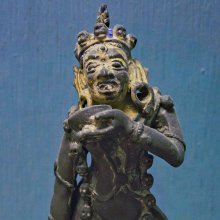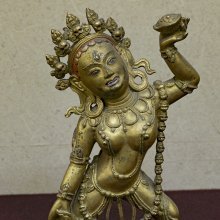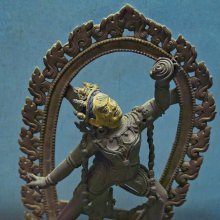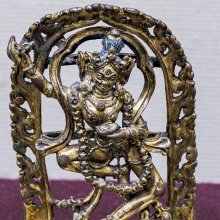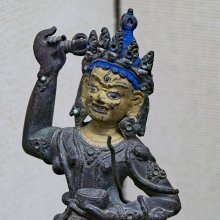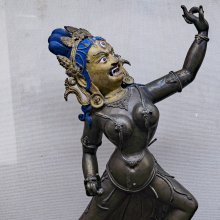Vajrayogini, Vajrayoginī, Vajra-yogini: 9 definitions
Introduction:
Vajrayogini means something in Buddhism, Pali, Hinduism, Sanskrit, the history of ancient India. If you want to know the exact meaning, history, etymology or English translation of this term then check out the descriptions on this page. Add your comment or reference to a book if you want to contribute to this summary article.
Images (photo gallery)
(+10 more images available)
In Hinduism
Shaktism (Shakta philosophy)
Source: Google Books: ManthanabhairavatantramVajrayoginī (वज्रयोगिनी) is the Goddess associated with Adhāmnāya (one of the six āmnāyas), according to Mukundarāja’s Saṃvartārthaprakāśa.—[...] Only the northern, western and upper āmnāyas are extensively functional amongst the Newars, in theory, like other Kaulas, they follow a system of six āmnāyas. This is largely based on the Parātantra. Thus, those listed in the Saṃvartārthaprakāśa by Mukundarāja, who was a Newar, agree with that source. The goddesses in the six āmnāyas are: [e.g., Below: Adhāmnāya—Vajrayoginī]. [...]

Shakta (शाक्त, śākta) or Shaktism (śāktism) represents a tradition of Hinduism where the Goddess (Devi) is revered and worshipped. Shakta literature includes a range of scriptures, including various Agamas and Tantras, although its roots may be traced back to the Vedas.
In Buddhism
Tibetan Buddhism (Vajrayana or tantric Buddhism)
Source: archive.org: The Indian Buddhist IconographyVajrayoginī (वज्रयोगिनी) refers to one of the various emanations of Ratnasambhava, as mentioned in the 5th-century Sādhanamālā (a collection of sādhana texts that contain detailed instructions for rituals).—Vajrayoginī is another of the important and popular goddesses who does not seem to bear the image of any of the Dhyāni Buddhas on the crown. Vajrayoginī is one of the consorts of Heruka, who remains with her in Yab-Yum, and their union is the subject of the celebrated Heruka-Tantra.
Vajrayoginī (first variety).—[Her Colour is yellow; her Āsana is the ālīḍha; her Symbols are the kartri and severed head; she has two companions and two arms.].—The Dhyāna (meditation instructions) is described in the Sādhanamālā as follows:—
“The worshipper should conceive himself as Bhaṭṭārikā Vajrayoginī ...of yellow colour, who carries in her left hand her own head severed by herself with her own Kartri held in her right hand. Her left hand is raised upwards while the right is placed below. She is nude, and her right leg is stretched while the left is bent down. He (the worshipper) should also meditate on the streams of blood issuing from the severed body as falling into the mouth of the severed head and into the mouths of the two Yoginīs on either side of her.
He (the worshipper) should also, conceive the two Yoginīs to the left and right (of the principal goddess), the green Vajravarṇanī and the yellow Vajravairocanī, both of whom carry the kartri in their left and right hands respectively, and the cup made of a skull in the right and left hands respectively. Their left and right legs respectively are stretched forward, while the other legs are bent, and they have dishevelled hair. On all sides, between the two Yoginīs and in the firmament there is the awful cremation ground”.
Vajrayoginī (second variety).—[Her Colour is red; her Vāhana is the corpse; her Symbols are the vajra and kapāla; her Āsana is the ālīḍha.].—The Dhyāna (meditation instructions) is described in the Sādhanamālā as follows:—
[The Red form is no less terrible than the one described above. She is surrounded on all sides by the terrible burning grounds. She stands in the ālīḍha attitude, on the orb of the sun, is in the prime of youth, and has red complexion. She rides the corpse, is nude, has three eyes, red and round, contorted brows, protruding belly and tongue, and is endowed with the six auspicious symbols. She carries the kapāla in the left hand and the vajra in the right, while the khaṭvāṅga hangs from her left shoulder.
This form of Vajrayoginī is similar in many respects to the forms of both Nairātmā and Vajravārāhī, so much so, indeed, that a confusion is likely to arise in the identification of their images. If an image shows the dancing attitude in ardhaparyaṅka, it may be identified as Nairātmā or Vajravārāhī, but if it shows the ālīḍha attitude, it may have to be identified as Vajrayoginī. The excrescence near the right ear arid the corpse lying on its chest is peculiar only to Vajravārāhī; while the absence of the excrescence and the corpse lying on its back point to Nairātmā. The ālīḍha attitude is peculiar only to Vajrayoginī.]
Vajrayoginī (third variety).—[Her Colour is yellow; her Symbols are the kartri and kapāla; she has two arms.].—The Dhyāna (meditation instructions) is described in the Sādhanamālā as follows:—
Source: OSU Press: Cakrasamvara Samadhi[Vajrayoginī may also have a Yellow form, when according to the sādhana, she will carry the kartri and the kapāla, but in other respects will be identical with the one just described Another sādhana adds the information that the kapāla should be filled with the blood of the Devas (gods) and the Asuras (demons) and that the hand carrying the kartri may show the tarjanī also.]
Vajrayoginī (वज्रयोगिनी) is the name of a deity, according to the Saṃvaramaṇḍala of Abhayākaragupta’s Niṣpannayogāvalī, p. 45 and n. 145; (Cf. Cakrasaṃvaratantra, Gray, David B., 2007).—Vajravārāhī appears both with Cakrasaṃvara, and on her own, both as Vajravārāhī and Vajrayoginī. [...] Vajrayoginī is in pratyālīḍhāsana, the counter posture to ālīḍha, indicating an aggressive feminine Buddha nature, and is pouring the amṛita from her kapāla into her mouth, savoring her own bliss. Vajravārāhī and Vajrayoginī are both red, nagnā, "naked", have muktakeśā, "loosened hair", one face and two arms, three eyes, holding a kartika in the right hand, and kapāla in the left, a garland of fifty dried human skulls, five bone ornaments, a crown of five skulls, and hold a khaṭvāṅga. [...]. Both Vajravārāhī and Vajrayoginī have their own iconographic meanings with and without Cakrasaṃvara.

Tibetan Buddhism includes schools such as Nyingma, Kadampa, Kagyu and Gelug. Their primary canon of literature is divided in two broad categories: The Kangyur, which consists of Buddha’s words, and the Tengyur, which includes commentaries from various sources. Esotericism and tantra techniques (vajrayāna) are collected indepently.
General definition (in Buddhism)
Source: WikiPedia: BuddhismVajrayoginī (lit. “the diamond female yogi”) is a highest yoga tantra yidam (iṣṭha-devatā), and her practice includes methods for preventing ordinary death, intermediate state (bardo) and rebirth (by transforming them into paths to enlightenment), and for transforming all mundane daily experiences into higher spiritual paths. Vajrayoginī is a generic female yidam and although she is sometimes visualized as simply Vajrayoginī, in a collection of her sādhanas she is visualized in an alternate form in over two thirds of the practices.
Her other forms include Vajravārāhī (Tibetan: Dorje Pakmo) and Krodikali (or Krodhakali, Kālikā, Krodheśvarī, Tibetan: Troma Nagmo). Vajrayoginī is a Ḍākiṇī (an accomplished Yoginī or a female deity) and a Vajrayāna Buddhist meditation deity. As such she is considered to be a female Buddha. Vajrayoginī is often described with the epithet sarva-buddha-dakinī, meaning “the Ḍākiṇī who is the essence of all Buddhas”.
Vajrayoginī’s sādhana, or practice, originated in India between the tenth and twelfth centuries. It evolved from the Chakrasaṃvara sādhana, where Vajrayoginī appears as his Yab-Yum consort, to become a stand-alone practice of Anuttarayoga Tantra in its own right. The practice of Vajrayoginī belongs to the Mother Tantra (Standard Tibetan: ma-rgyud) class of Anuttarayoga Tantra, along with other Tantras such as the Cakrasaṃvara Tantra and the Hevajra Tantra.
India history and geography
Source: archive.org: The Indian Buddhist Iconography (history)Vajrayoginī (वज्रयोगिनी) is the name of an ancient village situated in the Pargaṇā Vikrampur area of the Vaṅga-Samataṭa region.—In this Pargaṇā Vikrampur there is a fairly large and well-populated village which is now known by the rather extraordinary name of Vajrayoginī. Round about this village numerous Vajrayāna images have been discovered, and among them may be noticed images of Jambhala, Parṇaśabarī, Vajrasattva and Tārā. The term ‘Vajra’ in Vajrayoginī is also a familiar Buddhist word. Vajra is equivalent to Śūnya. Vajrayoginī is a Buddhist deity which the Hindus borrowed in the form of Chinnamaṣṭā. Thus the name of the village appears to be unmistakably Buddhist. The village must have derived its name from the temple of Vajrayoginī which was in existence in early times.
Vajrayoginī is possibly identified with Uḍḍiyāna.—It has already been pointed out that the temples dedicated to Vajrayoginī could only be expected at four places, Kāmākhyā, Sirihaṭṭa, Pūrṇagiri and Uḍḍiyāna. Out of these Kāmākhyā and Sirihaṭṭa (Sylhet) still retain their original names. Pūrṇagiri which signifies a hill is not identified yet with certainty. But it is possible to spot the fourth place [viz., Uḍḍiyāna] which is connected with Vajrayoginī. Thus it becomes evident that the present village Vajrayoginī was originally known as Uḍḍiyanā but as the deity Vajrayoginī became more popular later, the original name gradually disappeared giving place to the name of the deity. Tantrism of the Buddhists therefore originated here in Uḍḍiyanā-Vajrayoginī, and thence was transmited to the rest of India.

The history of India traces the identification of countries, villages, towns and other regions of India, as well as mythology, zoology, royal dynasties, rulers, tribes, local festivities and traditions and regional languages. Ancient India enjoyed religious freedom and encourages the path of Dharma, a concept common to Buddhism, Hinduism, and Jainism.
Languages of India and abroad
Sanskrit dictionary
Source: Cologne Digital Sanskrit Dictionaries: Edgerton Buddhist Hybrid Sanskrit DictionaryVajrayoginī (वज्रयोगिनी).—(compare Vajrā), name of a yoginī: Sādhanamālā 452.6 etc.
Source: Cologne Digital Sanskrit Dictionaries: Monier-Williams Sanskrit-English DictionaryVajrayoginī (वज्रयोगिनी):—[=vajra-yoginī] [from vajra > vaj] f. Name of a goddess, [Buddhist literature]
[Sanskrit to German]
Sanskrit, also spelled संस्कृतम् (saṃskṛtam), is an ancient language of India commonly seen as the grandmother of the Indo-European language family (even English!). Closely allied with Prakrit and Pali, Sanskrit is more exhaustive in both grammar and terms and has the most extensive collection of literature in the world, greatly surpassing its sister-languages Greek and Latin.
Nepali dictionary
Source: unoes: Nepali-English DictionaryVajrayoginī (वज्रयोगिनी):—n. name of a Buddhist goddess;
Nepali is the primary language of the Nepalese people counting almost 20 million native speakers. The country of Nepal is situated in the Himalaya mountain range to the north of India.
See also (Relevant definitions)
Partial matches: Vajra, Yogini, Yokini.
Full-text (+5): Vajra, Pratyalidhasana, Kartari, Uddiyana, Nagna, Muktakesha, Kamakhya, Sirihatta, Vajravarahi, Mahasukha, Svabhavaka, Tandava, Traidhatuka, Shyamadhumra, Jvalita, Ugratara, Shunyataprajna, Paryanka, Ardhaparyanka, Dakini.
Relevant text
Search found 11 books and stories containing Vajrayogini, Vajrayoginī, Vajra-yogini, Vajra-yoginī; (plurals include: Vajrayoginis, Vajrayoginīs, yoginis, yoginīs). You can also click to the full overview containing English textual excerpts. Below are direct links for the most relevant articles:
A Blessed Pilgrimage (by Dr. Yutang Lin)
The Indian Buddhist Iconography (by Benoytosh Bhattachacharyya)
Figure 191 - Emanations of Ratnasambhava: Vajrayoginī
Figure 159-160 - Emanations of Vairocana: Vajravārāhī
Varahi Tantra (English Study) (by Roberta Pamio)
The Goddess Vārāhī (Introduction)
Chapter 22 - The the Six Āmnāyas < [Summary of the Vārāhī Tantra]
Satirical works of Kshemendra (study) (by Arpana Devi)
5.17. The Female Mendicant (śramaṇikā) < [Chapter 5 - Kṣemendra’s objectives of Satire]
6. An Overview of the Previous Discussion < [Chapter 5 - Kṣemendra’s objectives of Satire]
Blue Annals (deb-ther sngon-po) (by George N. Roerich)
Chapter 10 - Origin of the Adamantine Garland (Vajrāvali) and other cycles < [Book 14 - Great Compassion Cycle]
Chapter 28 - Paṇḍita Vanaratna < [Book 10 - The Kālacakra]
Chapter 14c - Gyam bzang chos rje’s Disciples < [Book 8 - The famous Dakpo Kagyü (traditions)]
Lord Hayagriva in Sanskrit Literature (by Anindita Adhikari)
Yoginī Tantra < [Chapter 6]
